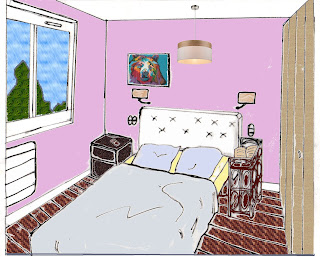[ENG] 7 secrets to design a comfortable wardrobe closet (a gift for you for 2022!)
(c) Maryna Zhegurova
I drew and ordered my first customized wardrobe in September 2021...
Hereunder are some photos of this piece of furniture - you will see them across the article... But as well, as a gift for 2022, I share with you my 7 important points to check - to design a comfortable #dressing-closet.
1. Measure your things to keep: clothes, accessories, everything you store in the dressing closet, differentiating things to fold and things to hang (dresses, pants, coats, etc.). So, how long will your future hanging rail be? How many shelves do your T-shirts, pullovers and jeans occupy today? And how big are these shelves?
2. Study well your new needs: to design a better version of your wardrobe comparing to the previous one, what do you need? Storing a step in it, to have it right next to the wardrobe closet... Where do you keep your bath towels? (probably, in the dressing, too). Where will you keep your dirty-clothes baskets ? (sometimes, if the bathroom is tiny, the dressing closet is a handy place for them, as well).
Would you prefer a new way of storing your trousers? (A trouser rack, instead of the former drawer or shelf ...) You have to think of everything, even of a place / space to store your "table extension" and/or your ironing board (sometimes in the wardrobe closet, too!); and think about your suitcases, duvets, if you keep them in the dressing closet, too...
3. Realize the fact, whether you like to store clothes vertically (as Marie Kondo, the Japanese master of decluttering and minimalism approach) - in drawers thus, or horizontally (a more common way) - using shelves.
4. Measure folded clothes and learn the space rules for their arrangement: for example, folded shirts occupy 35 to 40 cm of width and 40 cm of depth. And long hanging clothes (dresses, etc.) occupy 140 cm in height.
The recommended depth for the chest with hanging clothes is 52 to 60 cm. Therefore, corresponding spaces must be planned for these elements.
5. Know whether you want/need light in your closet - if so, provide an electrical outlet or a wire outlet on the wall or behind the wardrobe (to be done by your electrician upstream of the closet installation).
6. Think about doors/facades: do you want sliding doors? (Advantage - space saving, disadvantage - not allowing to see all your things at a glance and… their high price.) Folding doors - rare on the market. Swing doors: you need to have room for their opening, but also, probably, not to install the dressing closet in a "niche" (because if the doors of annex rooms are next to the wardrobe, they clutter up the space and add constraints: too many doors - complicated openings).
7. Measure your "height under the ceiling" (the ceiling height) in different places, your available width and depth. Also remember of noting whether there is a plinth in your room - important information for your carpenter or for you, before ordering your new storage closet.
In short, lots of things to think about. And if it is bothering you, you can delegate this project conception to professionals. There is me, for example, but also craftsmen-carpenters who do it. Any questions ? Feel free to contact me and to talk about it on 06 29 38 26 69!
Happy New Year 2022 ! :-D
P.S.: An important detail for me:
Sort and give away your unnecessary items ![]() , try to reconsider the clothes and accessories cluttering up your closets in vain, so that the new wardrobe closet or storage only host your "active" clothes - the ones you actually use.
, try to reconsider the clothes and accessories cluttering up your closets in vain, so that the new wardrobe closet or storage only host your "active" clothes - the ones you actually use.
Good mood to you in 2022! ![]()
***
mzhegurova@gmail.com (Maryna Zhegurova)
Facebook : Interior design Maryna
Based : F-92350 Le Plessis-Robinson (Paris region).







Commentaires
Enregistrer un commentaire